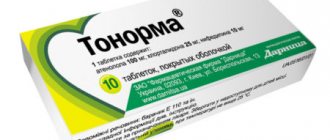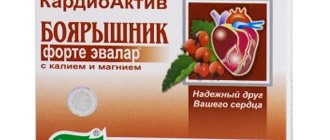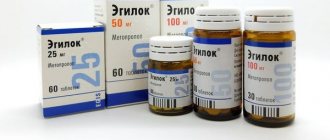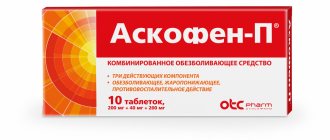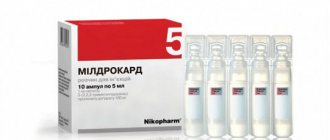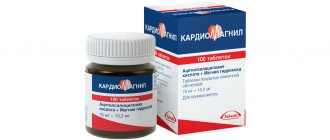Pharmacodynamics and pharmacokinetics
The drug has antiarrhythmic, antianginal, and hypotensive effects. It has negative dromotropic, chronotropic, inotropic and bathmotropic effects.
The hypotensive effect is achieved by influencing the nervous system, reducing the sensitivity of baroreceptors on the aortic arch, reducing the activity of the renin-angiotensin system , and reducing the IOC.
The drug reduces systolic and diastolic blood pressure, reduces IOC, SV.
The medication does not affect the tone of peripheral arteries in therapeutic doses.
The antianginal effect is ensured by a decrease in the oxygen demand of myocardial cardiomyocytes, which leads to a decrease in heart rate. The drug reduces heart rate at rest and during physical activity.
The antiarrhythmic effect is ensured by the elimination of arrhythmogenic factors (arterial hypertension, increased cAMP content, increased activity of the sympathetic nervous system, tachycardia), slowing down atrioventricular conduction , and reducing the rate of spontaneous excitation of the ectopic and sinus pacemaker.
When taking Atenolol, the survival rate of patients who have suffered a myocardial infarction increases significantly.
The drug does not weaken the bronchodilatory effect of isoproterenol.
Pharmacological properties of the drug Atenolol
A selective β1-adrenergic receptor blocker without BCA, which does not have membrane stabilizing activity. Due to its cardioselectivity and hydrophilicity, atenolol is much less likely to induce the development of bronchospasm and peripheral circulatory disorders, sleep or emotional disturbances. Cardioselectivity is lost when used in high doses. Reduces heart rate, cardiac output, systolic and diastolic blood pressure at rest and during exercise, has an antiarrhythmic effect by eliminating adrenergic effects on the heart, and reduces myocardial oxygen demand. Used as a hypotensive and antianginal agent. With long-term use, the antihypertensive activity of atenolol does not decrease. After oral administration, it is quickly but not completely absorbed from the digestive tract. 50–60% of the dose taken orally is absorbed, the remaining amount of atenolol is excreted unchanged in the feces. The β-adrenergic blocking effect of atenolol occurs within 1 hour after a single oral dose. The maximum effect develops after 2–4 hours. The half-life is 6–9 hours, however, the pharmacological effects of atenolol persist for a longer time (about 24 hours). In renal failure, the half-life is significantly prolonged. Less than 5% of atenolol is bound to plasma proteins, the volume of distribution is 0.7 l/kg body weight. Most of the atenolol that enters the systemic circulation (85%) is excreted unchanged in the urine. With long-term use, the pharmacokinetics of atenolol remains virtually unchanged. Penetrates the placental barrier and enters breast milk. Atenolol practically does not penetrate the BBB.
Indications for use of Atenolol
What are the pills for?
The medicine is prescribed for hypertensive crisis , arterial hypertension, angina pectoris, ischemic heart disease, neurocirculatory dystonia , hyperkinetic cardiac syndrome of functional origin, withdrawal syndrome, tremor, essential tremor, agitation.
The drug is recommended for use for the prevention of rhythm disturbances, myocardial infarction, ventricular extrasystole , sinus tachycardia, atrial flutter, atrial fibrillation, and ventricular tachycardia.
The medication is prescribed for migraine, thyrotoxicosis, pheochromocytoma .
Indications for use of Atenolol Nycomed are similar.
Contraindications
The medicine is not used for severe bradycardia, 2-3 degree atrioventricular block, cardiogenic shock , decompensated form of CHF, acute heart failure, SA blockade, Prinzmetal angina , intolerance to the active component, cardiomegaly, breastfeeding, taking MAO inhibitors.
For pulmonary emphysema, allergies, metabolic acidosis, diabetes mellitus, hypoglycemia, pheochromocytoma, bronchial asthma, thyrotoxicosis, myasthenia gravis, liver failure , pregnancy, psoriasis, depression, children and the elderly, and Raynaud's syndrome, the drug is used with caution.
Side effects
Sense organs: conjunctivitis , visual disturbances, dry eyes, decreased tear production, sore eyes.
Nervous system: depression, insomnia, headaches, dizziness, weakness, asthenia, drowsiness, depression, paresthesia in the extremities , impaired concentration, short-term memory loss, convulsions, myasthenia gravis.
Cardiovascular system: chest pain, vasculitis, coldness of the lower extremities, vasospasm, orthostatic hypotension, CHF, weakened myocardial contractility, arrhythmia, atrioventricular block, palpitations, bradycardia, myocardial conduction disturbances.
Digestive system: changes in taste perception, epigastric pain, nausea, vomiting, dry mouth, stool disorders: constipation , diarrhea.
Respiratory system: bronchospasm, laryngospasm , difficulty breathing, nasal congestion.
Endocrine system: hypothyroid state, hyperglycemia, hypoglycemia.
Skin: reversible alopecia, psoriasis-like skin rashes, increased sweating, exacerbation of psoriasis symptoms, skin hyperemia.
Also noted are back pain, bradycardia , decreased potency, decreased libido, arthralgia, and intrauterine growth retardation.
The severity of side effects directly depends on the dose of the drug.
Side effects of the drug Atenolol
Most side effects are mild and temporary. Most likely are bradycardia, a feeling of coldness in the extremities, paresthesia, pain in the lower extremities, nausea, increased concentrations of liver enzymes and/or bilirubin in the blood serum, dizziness, headache, orthostatic hypotension, collapse, fatigue, weakness, drowsiness, general malaise, depression, hallucinations, psychosis, diarrhea, nausea, dyspnea, psoriasiform rash or exacerbation of psoriasis, purpura, reversible alopecia, thrombocytopenia and visual disturbances. Atenolol, like other β-adrenergic receptor blockers, can promote the formation of antinuclear antibodies and the development of lupus syndrome.
Instructions for use of Atenolol (Method and dosage)
The tablets are taken orally, washed down with liquid, and do not chew.
The initial dosage is 25-50 mg per day, after a week, if necessary, the amount of the drug is increased by 50 mg, the average daily dosage is 100 mg.
For tachysystolic disorders and for ischemic heart disease, Atenolol is prescribed once a day, 50 mg.
Acute myocardial infarction with stable hemodynamic parameters: intravenous infusions, then take a 50 mg tablet after 10 minutes, repeat after 12 hours.
For cardiac hyperkinetic syndrome, 25 mg per day is indicated.
The drug is effective for 24 hours; the drug is not used more than once a day. It is not recommended to prescribe more than 200 mg per day. The medication is withdrawn gradually, every 3 days - ¼ dose.
Instructions for use of Atenolol Nycomed are similar.
Use of the drug Atenolol
For hypertension (arterial hypertension) it is prescribed orally at an initial dose of 50 mg once a day. Used as monotherapy or in combination with other antihypertensive drugs. The maximum therapeutic effect usually develops after 1–2 weeks of treatment. If necessary, the dose can be increased to 100 mg 1 time per day; further increase in dose does not increase the effectiveness of treatment. For angina pectoris, a dose of 50–100 mg is prescribed once a day; in some cases, to achieve optimal effect it is necessary to use atenolol at a dose of 200 mg once a day. Atenolol should be withdrawn gradually. Elderly patients and those with kidney disease may require a reduction in the dose of atenolol. With a creatinine clearance of 15–35 ml/min, the half-life of atenolol is 16–27 hours, and the maximum daily dose is 50 mg; with creatinine clearance less than 15 ml/min, the half-life is more than 27 hours, and the maximum daily dose is 25 mg. Patients on hemodialysis should be prescribed 25 or 50 mg of atenolol after each procedure (only in a hospital due to the possibility of a sharp decrease in blood pressure).
Overdose
Manifested by bronchospasm , cyanosis of the nail plates, convulsions , difficulty breathing, arrhythmia, fainting, drop in blood pressure, dizziness, severe bradycardia.
Emergency gastric lavage is required.
In case of atrioventricular conduction disturbance or bradycardia, atropine, epinephrine is administered intravenously, or a temporary pacemaker is installed.
If there is a sharp drop in blood pressure, the patient is placed in the Trendelenburg position .
In the absence of signs of pulmonary edema, plasma-substituting solutions are administered intravenously; in case of ineffectiveness, dobutamine , epinephrine, and dopamine are administered.
For convulsive syndrome, intravenous infusion of diazepam is indicated. Dialysis is effective.
Overdose of the drug Atenolol, symptoms and treatment
An overdose of atenolol has been described in patients who took a single dose of about 5 g. Early manifestations of an overdose are drowsiness, respiratory failure, wheezing, and bradycardia. Congestive heart failure, arterial hypotension, bronchospasm and hypoglycemia may develop. Gastric lavage is performed, activated charcoal is prescribed orally, and glucagon is administered. Atenolol can be removed from the systemic circulation by hemodialysis. For bradycardia or AV block, atropine or isoproterenol is administered; if drug treatment is ineffective, transesophageal pacing is performed. For congestive heart failure, digitalization is performed and diuretics are prescribed.
List of pharmacies where you can buy Atenolol:
- Moscow
- Saint Petersburg
Interaction
In patients taking Atenolol, allergen extracts for skin testing, as well as allergens for immunotherapy, significantly increase the risk of developing severe systemic allergic reactions, anaphylaxis. The risk of anaphylactic reactions increases with intravenous administration of radiocontrast agents.
A fall in blood pressure and cardiodepressive effects have been observed with intravenous infusion of phenytoin, as well as with the use of drugs for inhaled general anesthesia. The drug can mask the signs of developing hypoglycemia with the simultaneous use of oral hypoglycemic agents and insulin.
Atenolol reduces the clearance of xanthines and lidocaine . Estrogens, glucocorticosteroids, NSAIDs, BMCC, guanfacine, reserpine, methyldopa , cardiac glycosides, amiodarone, Diltiazem , Verapamil and many antiarrhythmic medications increase the likelihood of developing atrioventricular block, bradycardia, cardiac arrest, and worsening heart failure.
Hydralazine, sympatholytics, clonidine, diuretics, antihypertensive drugs, BMCC can significantly reduce blood pressure.
Atenolol prolongs the duration of action of coumarins, non-depolarizing muscle relaxants. Neuroleptics, sedatives, hypnotics, ethanol, tetracyclic and tricyclic antidepressants increase the inhibitory effect on the central nervous system.
The simultaneous administration of MAO inhibitors is unacceptable due to the risk of hypotension. Impaired peripheral circulation is observed when using medications with non-hydrogenated ergot alkaloids.
Drug interactions Atenolol
With the simultaneous use of atenolol with reserpine, methyldopa, clonidine, guanfacine and verapamil, severe arterial hypotension and bradycardia may develop. With simultaneous treatment with clonidine, it can be discontinued only a few days after stopping taking atenolol. Atenolol potentiates the hypoglycemic effect of oral antidiabetic agents and insulin. A few days before anesthesia with the use of drugs that have a cardiodepressive effect, it is necessary to stop taking atenolol; If it is impossible to discontinue atenolol, narcotic drugs with minimal negative inotropic effect should be used.
special instructions
Taking the drug should be accompanied by regular measurement of blood pressure, pulse, and sugar levels in people with diabetes .
Elderly patients are advised to periodically monitor the condition of the renal system. The doctor needs to instruct the patient and teach him how to measure heart rate correctly. In 20% of patients with angina, adrenergic blockers do not provide the desired effect due to severe coronary atherosclerosis with a low ischemic threshold and impaired subendocardial blood flow .
In patients with nicotine addiction, the effectiveness of Atenolol is significantly lower than in patients who do not smoke. During therapy, there may be a decrease in the production of tear fluid, which should be warned about in patients who wear contact lenses.
The drug may mask the clinical picture of thyrotoxicosis (tachycardia). Abrupt withdrawal of the drug in patients with thyrotoxicosis is unacceptable due to the risk of increasing the severity of the symptoms of the disease. Atenolol is able to mask tachycardia during hypoglycemia. The medication is discontinued several days before the planned general anesthesia with ether or chloroform. Otherwise, the patient is selected a drug for general anesthesia, which has minimal inotropic effects.
Intravenous administration of atropine eliminates reciprocal activation of the vagus nerve. The drug can be prescribed to patients with bronchospastic pathology if other antihypertensive drugs are ineffective or intolerant, subject to strict adherence to the dosage regimen.
If elderly people develop arterial hypotension, increasing bradycardia, ventricular arrhythmia, bronchospasm, severe disorders of the liver and kidneys, the dosage of the drug is reduced or therapy is stopped completely. If depression develops, the drug is replaced. Abrupt withdrawal can cause myocardial infarction, a severe form of arrhythmia. The drug is discontinued by gradually reducing the dosage over two weeks.
Before determining the level of normetanephrine, catecholamines, antinuclear body titers, and vanillylmandelic acid, Atenolol is discontinued. The medication affects the control of vehicles.
Recipe in Latin:
Rp: Atenololi 0.05 D. td N 30 in tab. S. 1 tablet 1 time per day.
Special instructions for the use of the drug Atenolol
Persons with coronary artery disease who have taken atenolol should be warned about the danger of abrupt withdrawal. In patients with angina pectoris, upon abrupt withdrawal of beta-adrenergic receptor blockers, a withdrawal syndrome of varying severity is observed (from an increase in frequency and intensity of angina attacks to myocardial infarction and cardiac arrhythmias). The relative β1-selectivity of atenolol allows it to be used with caution in patients with bronchospastic diseases resistant to other antihypertensive drugs. Atenolol should be prescribed in minimally effective doses. Atenolol should be prescribed with caution to patients with diabetes mellitus, since β-adrenergic receptor blockers can mask the manifestations of hypoglycemia and potentiate the hypoglycemic effect of antidiabetic agents; β-adrenergic receptor blockers can mask the severity of some clinical manifestations of hyperthyroidism (for example, eliminate tachycardia). Abrupt withdrawal of β-adrenergic receptor blockers can provoke the development of a thyrotoxic crisis, therefore, if it is necessary to discontinue β-adrenergic receptor blockers in such patients, careful medical supervision is required. Atenolol penetrates the placental barrier and may have a pathological effect on the fetus. Prescribing atenolol starting from the second trimester of pregnancy can lead to the birth of premature babies. Atenolol is excreted in breast milk, so children may experience severe bradycardia. Caution should be exercised when prescribing atenolol during breastfeeding. Premature babies and children with kidney damage are more likely to develop side effects. The safety and effectiveness of atenolol in pediatric practice have not been established.
Atenolol's analogs
Level 4 ATC code matches:
Biol
Metocard
Metozok
Nebilet
Nebilong
Betaxolol
Bisogamma
Aritel
Cordinorm
Vasocardin
Corvitol
Bidop
Bisoprolol
Nebivolol
Biprol
Bisoprol
Concor Cor
Lokren
Concor
Niperten
Analogues of Atenolol are the following products: Atenobene , Atenova , Atenol , Tenolol.
Reviews of Atenolol
The drug is effective for hypertension and arrhythmia, and is quite inexpensive. However, side effects are common, such as hallucinations and a decrease in blood sugar. Reviews of Atenolol Nycomed are generally better than those of drugs produced by other manufacturers.
Reviews during pregnancy are generally positive; those who used the medication mostly did not notice any side effects. However, it should be remembered that according to the results of clinical studies, such side effects on the fetus are very possible.
Atenolol price, where to buy
Price Atenolol 25 mg, 30 tablets - 17 rubles.
50 mg, 30 pieces - 21 rubles.
- Online pharmacies in RussiaRussia
- Online pharmacies in UkraineUkraine
- Online pharmacies in KazakhstanKazakhstan
ZdravCity
- Atenolol tab.
0.05g 30 pcs. Borisov Medical Preparations Plant OJSC 15 rub. order - Atenolol tablets 100 mg 30 pcs. AO Update PFC
42 RUR order
- Atenolol tab. 50mg 30pcs Pliva
46 RUR order
- Atenolol tablets 100 mg 30 pcs JSC Marbiopharm
45 rub. order
- Atenolol tablets 50 mg 40 pcs JSC Marbiopharm
26 RUR order
Pharmacy Dialogue
- Atenolol (tablet p/o 50 mg No. 30)Pliva
57 RUR order
- Atenolol tablets 100 mg No. 30Update PFK ZAO
43 RUR order
- Atenolol tablets 50 mg No. 30Ozon LLC
22 RUR order
- Atenolol tablets 50 mg No. 30Update PFK ZAO
44 RUR order
show more
Pharmacy24
- Atenolol-Zdorovye 0.05 g No. 20 tablets TOV" Pharmaceutical company "Zdorovya", Kharkiv, Ukraine
9 UAH. order - Atenolol-Astrapharm 50 mg No. 20 tablets TOV Astrapharm, Ukraine
7 UAH order
- Atenolol-Astrapharm 100 mg No. 20 tablets TOV Astrapharm, Ukraine
11 UAH order
- Atenolol 50 mg No. 20 tablets PAT Monpharm, Ukraine
8 UAH order
PaniPharmacy
- ATENOLOL tablets Atenolol tablets 50 mg No. 20 Ukraine, Astrapharm LLC
8 UAH order
- ATENOLOL tablets Atenolol tablets 100 mg No. 20 Ukraine, Astrapharm LLC
12 UAH order
- ATENOLOL tablets Atenolol tablets 50 mg No. 20 Ukraine, Monfarm JSC
9 UAH order
- ATENOLOL tablets Atenolol tablets 50 mg No. 20 Ukraine, Health LLC
11 UAH order
show more


